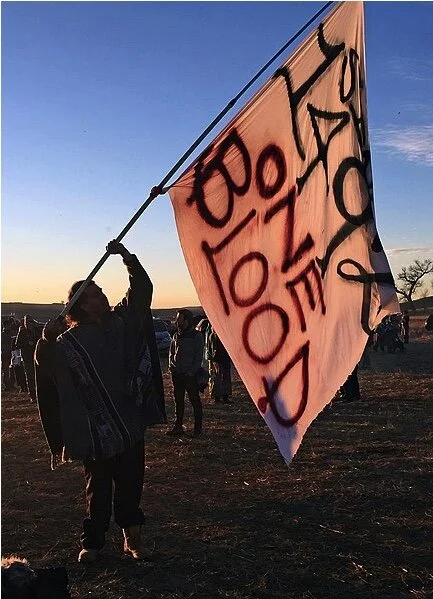The complexity of the oil industry and the massive influence of big money over environmental and public health decisions often leaves the small battles to be squashed before they have seen the surface. But recent fights over land rights, have led to some large victories. Home owners, environmental groups, and tribes have all made strides against companies in their area; can these local battles gain headway on a national level?
Flag at a protest for the construction of the Dakota Access Pipeline. Becker1999. CC-BY-2.0.
Oil has hit a cornerstone between immense support from Trump’s administration and increasing heat from environmental activists. Often oil companies are in the news when facing massive consequences for oil spills. But, people that live near drilling sites or along pipelines can face health effects and unfair treatment from corporate and government agencies every day.
The biggest culprits are often in rural areas where people are dependent on the land for their livelihood. For example, a pipeline being built from western Texas to the Gulf cuts straight through Hill Country and the ranches there. This is even true for areas designated as private conservation land that is supposed to be protected from any development. The building raises concerns for environmental, aesthetic, and public health reasons.
The same problem is found in West Virginia, where pipeline development cuts through private homes. If the owners refuse to sell their land, it can be taken legally through Eminent Domain. This will continue to become more popular in the next 15 years as there is an estimated 26,000 miles of new gas pipelines to be built. People are starting to sue to bring the problem to the Supreme Court. The increased danger of living next to a pipeline can lead to cancer, contaminated drinking water, and increased dangers if the line were to break or become damaged.
One of the biggest groups fighting against pipelines are native tribes. The Sioux gained attention at Standing Rock while fighting the production of the Dakota Access Pipeline. In the Upper Midwest, rights to Line 5 are being revoked on reservations. In Alaska, Inuit tribes are fighting drilling in the Arctic National Wildlife Reserve (ANWR) which has been opened up to drilling for the first time under the Trump administration.
The ANWR and the Arctic are thought to be some of the largest untapped oil reserves in the world. Climate change has increased access to areas of the region that couldn’t be reached before, yet the environmental risk of drilling and transporting in an extremely unique and fragile ecosystem has led to a lot of resistance. In the ANWR, drilling is thought to upset Caribou migration and breeding grounds, which the local people rely on as a food source and cultural significance.
In the US, it often seems like these fights always end in the same way, but in Ecuador and Canada tribes have main significant gains against drilling. In the Amazon, the Waorani won a landmark case against the Ecuadorian government that was trying to open the rainforest to mining. The government hoped to bring more cash into the country but would do so at a huge environmental and cultural cost. One that the Waorani wouldn’t allow. The area covered 7 million acres of Indigenous land. The Waorani said that is about more than the land but instead about a way of living that supports the lives of others.
In Canada, fights against seismic blasts to find offshore oil reserves had great success to protect the local ecosystem. The local Inuit of Clyne River joined with Greenpeace and grassroots environmental movements to bring it to national attention. Now Arctic off-shore blasting has seen its final days. There are great strides to be made by fighting the daily impacts of oil and gas drilling. If anything, increasing drilling and pipeline construction is continuing our dependence on one of the most carbon-dense energy sources in the world.
DEVIN O’DONNELL’s interest in travel was cemented by a multi-month trip to East Africa when she was 19. Since then, she has continued to have immersive experiences on multiple continents. Devin has written for a start-up news site and graduated from the University of Michigan with a degree in Neuroscience.




